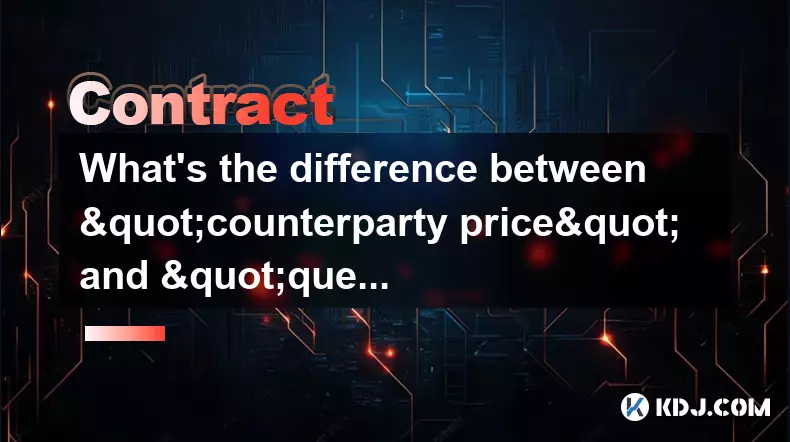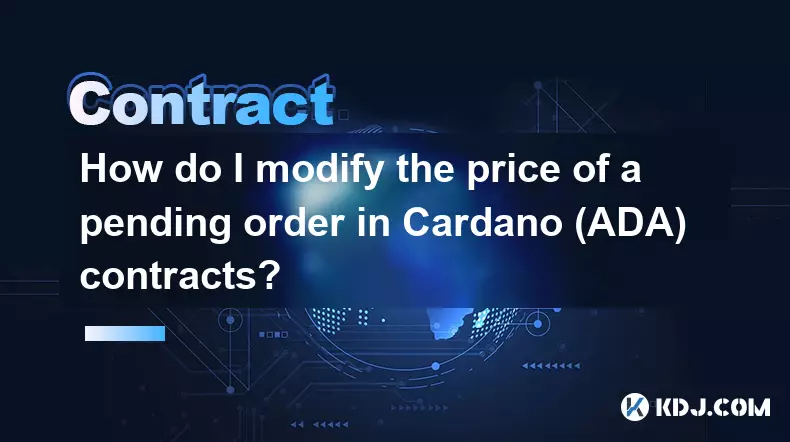-
 bitcoin
bitcoin $109523.663807 USD
-0.13% -
 ethereum
ethereum $4019.526508 USD
2.06% -
 tether
tether $1.000482 USD
0.00% -
 xrp
xrp $2.776815 USD
0.18% -
 bnb
bnb $958.942396 USD
0.12% -
 solana
solana $204.294698 USD
3.84% -
 usd-coin
usd-coin $0.999693 USD
0.00% -
 dogecoin
dogecoin $0.232115 USD
2.09% -
 tron
tron $0.338028 USD
0.84% -
 cardano
cardano $0.790920 USD
1.50% -
 hyperliquid
hyperliquid $44.871443 USD
5.60% -
 ethena-usde
ethena-usde $1.000322 USD
0.04% -
 chainlink
chainlink $21.034165 USD
2.60% -
 avalanche
avalanche $28.794831 USD
-0.54% -
 stellar
stellar $0.360466 USD
1.24%
What's the difference between "counterparty price" and "queue price" in futures trading?
The counterparty price is the best available bid or ask for immediate execution, while queue price determines priority for limit orders waiting in the order book.
Sep 21, 2025 at 01:19 am

Understanding Counterparty Price in Futures Trading
1. The counterparty price refers to the best available price on the opposite side of a trade order book. When a trader wants to buy a futures contract, the counterparty price is the lowest ask price listed by sellers. Conversely, when selling, it reflects the highest bid price offered by buyers.
2. This price is crucial for immediate execution. Market orders rely heavily on the counterparty price because they are designed to fill instantly at the most favorable current rate provided by the opposing side of the market.
3. The counterparty price dynamically shifts as new orders enter or existing ones are canceled from the order book, reflecting real-time supply and demand imbalances.
4. Traders monitoring depth-of-market (DOM) data can observe multiple levels of counterparty pricing, not just the top-of-book level. This helps assess potential slippage when executing large orders.
5. In fast-moving markets, especially during high volatility events common in crypto futures, the counterparty price may change rapidly between the time an order is submitted and when it is filled.
The Role of Queue Price in Order Execution
1. The queue price pertains to limit orders resting within the order book at a specified price level. It represents where an order stands in line among other pending orders at that same price tier.
2. Unlike the counterparty price, which focuses on immediate execution against existing offers, the queue price determines priority for non-marketable limit orders waiting to be filled.
3. Exchanges typically use a price-time priority model. An order with a more aggressive price takes precedence, but among orders at the same price, the one placed earliest gets priority—this is the essence of queue positioning.
4. In highly liquid cryptocurrency futures markets, even small differences in timing can significantly affect whether a limit order gets executed before others at the same price level.
5. High-frequency trading (HFT) firms often optimize their infrastructure to gain microseconds of advantage in placing orders ahead of competitors, directly impacting their position in the queue.
Market Dynamics Influencing Both Prices
1. Liquidity concentration plays a major role. In popular futures contracts like Bitcoin or Ethereum perpetuals, deep order books mean numerous price levels exist both above and below the current mark price.
2. Sudden news events or macroeconomic announcements can trigger cascading liquidations, causing the counterparty price to gap through several levels while reshuffling queue positions across multiple price tiers.
3. Funding rates in perpetual futures contracts influence trader behavior, indirectly affecting both counterparty availability and willingness to place limit orders into the queue.
4. Arbitrageurs constantly monitor discrepancies between spot and futures prices, using both market and limit orders to exploit inefficiencies, thereby interacting with both counterparty and queue pricing mechanisms.
5. Exchange-specific features such as post-only orders, hidden orders, or iceberg orders allow traders to manipulate how their bids or asks appear in the queue without immediately hitting the counterparty price.
Frequently Asked Questions
What happens if there’s no counterparty price available?When no matching counterparty exists, market orders cannot execute. This situation occasionally occurs in low-liquidity altcoin futures during extreme volatility or technical outages. Orders may fail or partially fill depending on exchange rules.
Can I see my exact position in the order queue?Most centralized exchanges do not expose full queue position data publicly. Some platforms provide partial insights via API feeds showing volume at each price level, but precise placement relative to other traders' orders remains opaque.
Does placing a limit order always guarantee a spot in the queue?No. If a limit order is placed at a price that would immediately match the counterparty price, it may be rejected or converted into a market order depending on the exchange's settings. Post-only orders are used to ensure entry into the queue without crossing.
Disclaimer:info@kdj.com
The information provided is not trading advice. kdj.com does not assume any responsibility for any investments made based on the information provided in this article. Cryptocurrencies are highly volatile and it is highly recommended that you invest with caution after thorough research!
If you believe that the content used on this website infringes your copyright, please contact us immediately (info@kdj.com) and we will delete it promptly.
- Sleep Token's Macabre Metal: A Ritualistic Rise to Rock Stardom
- 2025-09-27 22:25:15
- BlockchainFX: Is This Presale the Next Binance?
- 2025-09-27 22:25:15
- ORDER Token's Binance Listing Ignites Crypto Rally: What Traders Need to Know
- 2025-09-27 22:30:01
- Ethereum ETFs Feel the Heat: Investors Exit as Staking Approval Looms?
- 2025-09-27 22:30:01
- Crypto Presales & Meme Coins: Hunting for the Next 100x Opportunity
- 2025-09-27 22:30:01
- Cardano (ADA) Price Prediction: Bullish Scenarios and Market Dynamics
- 2025-09-27 22:30:16
Related knowledge

How do I enable the "scalping-only" mode for Cardano (ADA) contracts?
Sep 24,2025 at 03:19am
Understanding Scalping Strategies in Crypto Derivatives1. Scalping in cryptocurrency trading refers to executing multiple short-term trades within min...

How do I add margin to Cardano (ADA) contracts?
Sep 27,2025 at 07:54pm
Understanding Margin in Cardano (ADA) Smart ContractsCardano operates on a proof-of-stake blockchain that supports smart contracts through its Plutus ...

What is the maximum position limit for Cardano (ADA) contracts?
Sep 23,2025 at 11:00pm
Understanding ADA Futures and Derivatives Market Structure1. Cardano (ADA) futures contracts are offered by several major cryptocurrency derivatives e...

What is the maker fee for Cardano (ADA) contracts?
Sep 26,2025 at 09:01am
Understanding Maker Fees in Cardano (ADA) Contracts1. The concept of maker fees applies broadly across decentralized exchanges and smart contract plat...

How can I view open interest in Cardano (ADA) contracts?
Sep 24,2025 at 07:36am
Understanding Open Interest in Cardano Derivatives1. Open interest refers to the total number of outstanding derivative contracts, such as futures or ...

How do I modify the price of a pending order in Cardano (ADA) contracts?
Sep 27,2025 at 01:00am
Understanding Pending Orders in Cardano Smart Contracts1. Cardano operates on a proof-of-stake blockchain that supports smart contracts through its Pl...

How do I enable the "scalping-only" mode for Cardano (ADA) contracts?
Sep 24,2025 at 03:19am
Understanding Scalping Strategies in Crypto Derivatives1. Scalping in cryptocurrency trading refers to executing multiple short-term trades within min...

How do I add margin to Cardano (ADA) contracts?
Sep 27,2025 at 07:54pm
Understanding Margin in Cardano (ADA) Smart ContractsCardano operates on a proof-of-stake blockchain that supports smart contracts through its Plutus ...

What is the maximum position limit for Cardano (ADA) contracts?
Sep 23,2025 at 11:00pm
Understanding ADA Futures and Derivatives Market Structure1. Cardano (ADA) futures contracts are offered by several major cryptocurrency derivatives e...

What is the maker fee for Cardano (ADA) contracts?
Sep 26,2025 at 09:01am
Understanding Maker Fees in Cardano (ADA) Contracts1. The concept of maker fees applies broadly across decentralized exchanges and smart contract plat...

How can I view open interest in Cardano (ADA) contracts?
Sep 24,2025 at 07:36am
Understanding Open Interest in Cardano Derivatives1. Open interest refers to the total number of outstanding derivative contracts, such as futures or ...

How do I modify the price of a pending order in Cardano (ADA) contracts?
Sep 27,2025 at 01:00am
Understanding Pending Orders in Cardano Smart Contracts1. Cardano operates on a proof-of-stake blockchain that supports smart contracts through its Pl...
See all articles









































































